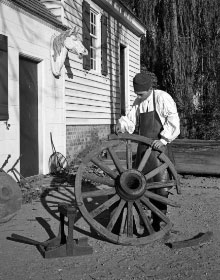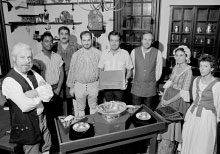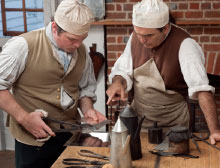

The Development of Historic Trades at Colonial Williamsburg
Building the Foundations
With nearly 80 years of experience, our Historic Trades department serves the vital function of not only sharing their knowledge with visitors but also of preserving and passing down these resurrected skills.
Historic trades have been actively interpreted at Colonial Williamsburg since 1935, making ours the longest-running in America. In that year, the Foundation began restoring two carriages for public use—embarking on its first venture in understanding and applying a colonial trade. Public interpretation of trades began in 1936. By 1940 cabinetmaking, blacksmithing, pewtersmithing, bootmaking, wigmaking, and spinning and weaving were being demonstrated for visitors.
Following a lull during World War II, Historic Trades began expanding again. In 1950, the Printing Office and the Pasteur & Galt Apothecary Shop opened. Shortly afterwards the first reconstruction of a coach began, marking the beginnings of the wheelwright's shop. By 1956 visitors could also visit the bookbinder, millinery, and silversmith shops.
A Commitment to Authenticity
At first, trade shops were placed wherever convenient. But in 1958, the Printshop and Bindery were in installed in their original locations—a commitment to authenticity and the historical record which has continued ever since. In 1966, the Anthony Hay Cabinetmaker and the Elkanah Deane Wheelwright shops opened on their original sites. The foundry was establish on the James Geddy site two years later.
The 1960s also witnessed the addition of coopering, gunsmithing, and basketmaking to the list of skills practiced in the Historic Area. In the 1970s, the first wheelwright was hired, musical instrument-making and historic foodways were added, and the Coach and Livestock Department joined the Trades Department. Agriculture made its debut in the 1980s. Later that decade, the carpenters' shop opened and basketmaking began to be interpreted at the George Wythe House.

Recent Developments
In 1986, Colonial Williamsburg took its commitments to preservation and interpretation further when the James Anderson Blacksmith Shop was built on its original site using historically-correct methods—an ongoing practice as much as possible, as the recent reconstructions of the Charlton Coffeehouse, the Anderson Armoury site, and the Markethouse demonstrate. That year also saw the beginnings of brickmaking as a trade at Colonial Williamsburg, and their ongoing efforts have literally laid the foundations for these recent reconstructions.
In the early 1990s, several shops launched their ongoing internal apprenticeship programs. In the spirit of 18th-century apprenticeships, they require that would-be journeymen demonstrate mastery of both basic and advanced techniques. The most recent addition to the Historic Trades Department was the tin shop in 2013, opened as part of the reconstructed Armoury, bringing the number of trades interpreted in Colonial Williamsburg to 22.
